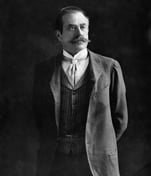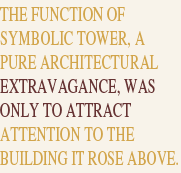
Written by Louis Werner
 hen the Almohad caliph Abd al-Mu’min ibn Ali left his Berber stronghold in North Africa to invade Al-Andalus in 1146, he could hardly have imagined that, along with his army and his reformist faith, he was crossing the Straits of Gibraltar with an architectural archetype that—700 years later—would be copied, adapted and rebuilt again and again in America.
hen the Almohad caliph Abd al-Mu’min ibn Ali left his Berber stronghold in North Africa to invade Al-Andalus in 1146, he could hardly have imagined that, along with his army and his reformist faith, he was crossing the Straits of Gibraltar with an architectural archetype that—700 years later—would be copied, adapted and rebuilt again and again in America.
Such was the influence of the classic Almohad minaret, as seen in the Kutubiyya of Marrakesh (begun in 1158, completed in 1195), the unfinished Hassan minaret in Rabat (begun in 1195) and, most famously, the Giralda of Seville (begun in 1184, completed in 1198). And such was the talent of a single American architect, Stanford White of the New York firm McKim, Mead and White, that his homage to the Giralda, the Madison Square Garden tower (begun in 1889, completed a year later), would become a template for grandiose corporate towers all over the United States.
Stanford White (1853–1906) was the leading architect of America’s “gilded age” at the turn of the 20th century, responsible for such New York City landmarks as the First Bowery Savings Bank, the Washington Square Arch and Judson Memorial Church. These and all of White’s buildings display elements of the Beaux Arts esthetic, which he had studied in Paris, a wildly creative amalgam of Classical, Gothic, Renaissance and Baroque elements and references.
As a student at the Ecole des Beaux Arts in Paris in 1878, White traveled in southern France and Italy—but not as far as Spain—absorbing all architectural traditions. If he had made it to Seville, he would no doubt have been impressed by the Giralda’s own amalgam of styles, from its Roman foundation stones, up its Almohad square shaft with decorative sebka masonry, blind arches, balconies and lobed windows, past its 30-meter-high (100'), five-level baroque belfry, added in the mid-16th century by Hernan Ruiz, and culminating in a weather vane in the shape of an allegorical female figure of Faith holding a shield and palm frond and spinning atop a ball pivot.
 |
 |
Instead of seeing the real Spain, White saw it in his imagination in the opera The Barber of Seville, whose performance he noted in a letter to his mother. He may also have read an 1885 issue of the leading professional magazine, American Architect, which featured floor plans, elevations and illustrations of the Giralda. We can only speculate that these experiences inspired him to emulate the Seville landmark when, in 1888, he won the commission to design a theater complex at the northeast corner of New York’s Madison Square, at 26th Street and Madison Avenue.
White designed this Madison Square Garden, the second in a series of four arenas by that name, as an ornate and expensive building, a full city block long and wide, with buff and yellow brick and terracotta ornament, an arched pedestrian colonnade and a tower culminating 105 meters (340') above street level with a four-meter (13') wind-pivoting statue of Diana, Roman goddess of the hunt, holding a bow and arrow. The tower came to be called the “Diana Tower,” just as the Giralda, whose name means “weather vane” in Spanish, takes its name from its uppermost part.
The New York Sun newspaper, perhaps immodestly, called the tower “the greatest achievement of the 19th century, unrivalled by any creation in art in many centuries.” But the tower itself—the city’s second-highest structure, illuminated with 1400 incandescent bulbs, 100 arc lights and two sweeping searchlights—was far from modest. An elevator ascended to a public viewing platform on its top loggia, just below the Diana statue, from which the view reached as far as Connecticut.
White’s tower was praised in a vehemently opinionated essay entitled “The Use and Abuse of Precedent,” published in 1893 by H. Langford Warren, an architecture critic and professor at Harvard University. The don warned, “Work that either from ignorance or of purpose attempts to dispense with precedent altogether or which uses the forms of past art without an intelligent knowledge of their meaning is not only ungrammatical but incoherent, formless, ugly…. It is to architecture what the gibbering of an idiot is to language.”
But White’s tower, Warren wrote, was “a splendid example of the best use of precedent. The language has been thoroughly mastered and is used with the utmost ease and freedom as well as with grace and beauty.” In his influential opinion, White’s version of the Giralda was a complete success. “Stage for stage, feature for feature,” Warren applauded, “the Seville tower is closely followed, and the architects of the New York tower have contrived to give a lightness and grace to their design.” The Diana tower, he concluded, had more “élan” than the Giralda itself.
He noted its “nobler proportions and more perfect harmony of parts”—and in fact the New York tower was taller and slimmer than its model, and bulged slightly in the middle in order to trick the eye into seeing it, from a distance, as perfectly straight. Although it lacked the decorative elements of the Almohad-era construction, Warren thought that the newer tower had “a unity of design which the Giralda, with its two styles, necessarily lacks, and the detail of its upper stages is generally more refined as well as richer.”

Given the visual clash between the Diana Tower’s utterly plain shaft and its exuberant upper colonnades and loggias, one might disagree with Warren’s view that the newer showed a superior stylistic unity to the older. However, as a principal theorist of the “American Renaissance,” a movement invoking quality and cultural values in all building, Warren’s opinion carried much weight. The idea of a purely symbolic tower, an architectural extravagance whose only function was to attract attention to the building it rose above, now had the imprimatur of the American Renaissance movement, and it became a touchstone for all corporate design.
Ironically, the Madison Square Garden tower came close to never being built. The breakneck day-and-night pace of construction of the main building, with 1000-man shifts working under artificial light, had stretched its investors, including White, to the limit, and it was momentarily decided not to complete the tower. Only when the contractor agreed to build it at half its $450,000 completion cost did it go forward.
Using White’s Diana tower itself as a precedent and model, architects in other parts of the country built towers that might be called third-generation heirs to the Giralda, among them San Francisco’s Ferry Terminal (1898), Buffalo’s Electric Tower (1901), Coney Island’s Dreamland Tower (1904), Chicago’s Wrigley Building (1921), Miami’s Freedom Tower (1925) and Coral Gables’ Biltmore Hotel (1926).
The completion of New York’s Art Deco-style Empire State Building in 1931, though it perhaps, through a squinted eye, might conjure up something of the Giralda, is considered the beginning of a forward-looking American corporate building style and the endpoint of the American Renaissance. But that did not mean the last of the Giralda look-alikes. In 1967, an exact half-scale replica of the Giralda was built as the centerpiece of Country Club Plaza, a Spanish Revival–themed shopping and entertainment complex in Kansas City, Missouri—the American sister city of Seville.
The end of White’s tower, and of White himself, was not kind. Madison Square Garden went bankrupt in 1925 and was quickly razed, tower and all. By a mean twist of fate, that decision was made by its mortgage holder, New York Life Insurance Company, for which years earlier White had designed an addition to its lower Manhattan office. The company built a new headquarters, featuring a pyramidal tower of squat and ugly proportions, on the very ruins of White’s.
Well before this demolition, which alone might have killed White’s spirit, he had been murdered while dining in Madison Square Garden’s rooftop restaurant. His killer blamed him for a rumored romantic involvement, which had supposedly unfolded in his private tower apartment, decorated with oriental divans and a muted light fixture in the shape of a Seville orange tree.
“It would take Scheherazade to describe it adequately,” wrote one of his visitors.
The trial of White’s killer took place in a New York courthouse with an extravagant Gothic tower modeled directly on Schloss Neuschwanstein, the castle of King Ludwig II of Bavaria, and voted one of America’s 10 most beautiful buildings in 1885. In the 1960’s, the courthouse and its tower were slated for demolition themselves, and only at the last moment were they saved by a group of architectural preservationists motivated, in part, by the razing of White’s landmark tower.
As a final coda to the story of the Diana Tower, a private four-story townhouse, located just two blocks from the site of White’s Madison Square Garden, collapsed without warning in October 2007—101 years after White’s death. It is said to have once housed one of his apartment-offices where he entertained, worked and drew inspiration from the city around him.
 |
Louis Werner is a free-lance writer and filmmaker who lives in New York. He can be reached at [email protected] |





